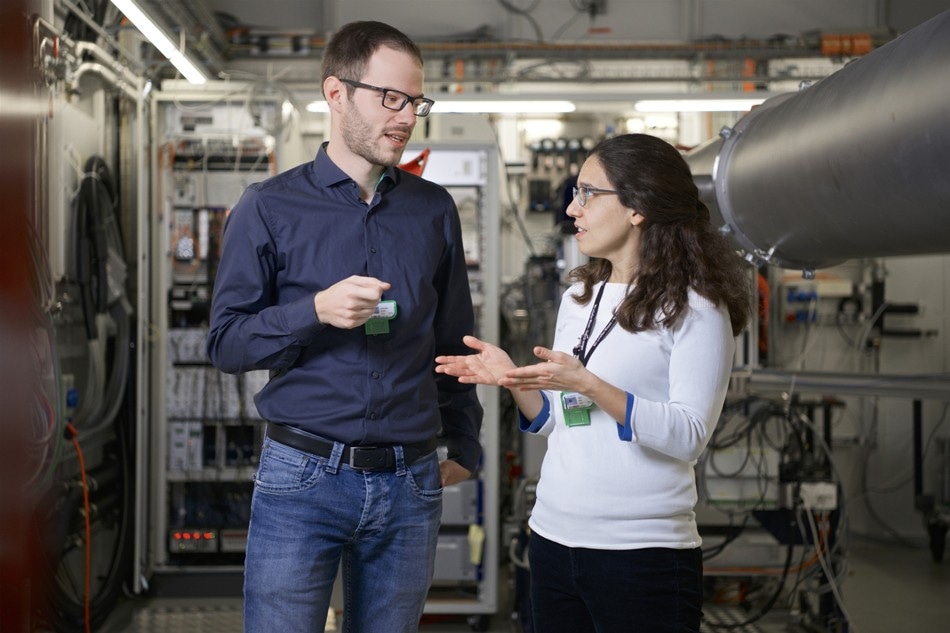Feb 4 2019
X-rays are known to offer interesting and detailed insights into the interior of cells, tissues, and materials. At the Paul Scherrer Institute (PSI), scientists have created a novel technique that takes X-ray images to a whole new level: the resolution is not only greater but also provides a more accurate understanding about the materials’ properties.
 Klaus Wakonig and Ana Diaz, together with other PSI researchers, have transferred the principle of Fourier ptychography to X-ray microscopy for the first time ever. (Image credit: Paul Scherrer Institute/Markus Fischer)
Klaus Wakonig and Ana Diaz, together with other PSI researchers, have transferred the principle of Fourier ptychography to X-ray microscopy for the first time ever. (Image credit: Paul Scherrer Institute/Markus Fischer)
To achieve this feat, the research team shifted the lens of an X-ray microscope and then recorded several separate images to produce the real picture using computer algorithms. In doing so, the researchers have redefined the principle of what is known as Fourier ptychography to X-ray measurements, for the first time ever. The study was performed at the Swiss Light Source SLS and has been reported in the journal Science Advances.
With the help of X-ray microscopes, PSI researchers were able to peer inside catalysts, computer chips, brain tissue, or tiny pieces of bone. Due to the short wavelength of the X-rays, details that are immeasurable times smaller than a grain of sand can be visualized—for example, structures in the nanometer range, that is, millionths of a millimeter. As in a typical microscope, the light scattered by the sample is collected by a lens, which forms a magnified image on the camera. However, minute structures tend to scatter light at extremely large angles. Hence, a correspondingly huge lens is required to achieve a high resolution in the image.
It remains extremely challenging to produce such large lenses. When working with visible light, there are lenses that can capture very large scattering angles. With X-rays, however, this is more complicated because of the weak interaction with the material of the lens. As a consequence, usually only very small angles can be captured, or the lenses are rather inefficient.
Klaus Wakonig, Physicist, Paul Scherrer Institute.
This problem is avoided by the latest technique devised by Wakonig and his colleagues. “The final image is as if we had measured with a large lens,” explained the researcher.
The researchers initially utilized a small yet efficient lens, like the one often used in X-ray microscopy, and moved it across an area that can be covered by a suitable lens. This practically produces a large lens.
In practice, we go to different points with the lens and take a picture in each place. Then we use computer algorithms to combine all the pictures to generate one high-resolution image.
Klaus Wakonig, Physicist, Paul Scherrer Institute.
From visible light to X-rays
Generally, lenses integrated into instruments are not moved away from the optical axis, because this tends to distort images. Conversely, since the researchers, in this case, are aware of the lens’ actual position and are able to illuminate a number of adjacent points, they can rebuild the way the light was scattered and also how exactly the sample looked like. Since 2013, the technique, called Fourier ptychography, has been applied in microscopy in the visible region. For the first time ever, the PSI researchers carried out experiments in which they successfully applied this principle to X-ray microscopy. “To the best of our knowledge no successful implementation of X-ray Fourier ptychography has been reported thus far,” reported the investigators in Science Advances.
The latest technique provides higher resolution and also two complementary kinds of imaging data. Firstly, just as with any standard camera, the amount of light absorbed by the object to be imaged needs to be measured; but in addition, the way in which the light is refracted is also recorded. Both phase contrast and absorption contrast are discussed by experts.
Our method provides the phase contrast, which is otherwise hard to obtain, practically for free. This makes the quality of the images much better.
Ana Diaz, Beamline Scientist, Paul Scherrer Institute.
In addition, through the phase contrast, conclusions regarding the material characteristics of the sample under analysis can possibly be made, which is often not possible with regular imaging methods.
Particularly interesting for biological samples
In their experiments, the investigators used a detector chip as the sample. In the coming days, the novel technique could be used for exposing, for instance, how and when a metal breaks under pressure, or how does a catalyst work when a gas is introduced. In addition, this method could even be used for studying cells and tissue aggregates. The team believes that this will provide a better understanding of the development of various diseases like hepatitis or Alzheimer’s.
Diaz described the benefits of the latest technique: “Biological samples normally do not have good absorption contrast. Here the phase contrast allows for a significantly improved image quality.” The team also believes that Fourier ptychography is gentler when compared to the earlier techniques. “A comparison with normal X-ray microscopy indicates that the new method requires a lower dose of radiation, because it is more efficient, stated Wakonig. “This could be particularly interesting for studies of biological samples.”
The team’s demonstration equipment was set up at the cSAXS beamline of the Swiss Light Source SLS. “At present, the experiments are still quite complex and require a lot of time, stated Diaz.For the novel technique to work, the X-rays that have been used had to be in a sort of unison—they must be coherent, as the investigators put it. Moreover, experiments such as these need large-scale research facilities like SLS. However, Wakonig is also exploring whether the technique could be achieved with less coherence. If the method is used for studying samples at regular laboratory X-ray sources, it would pave the way for a wide range of additional application areas.